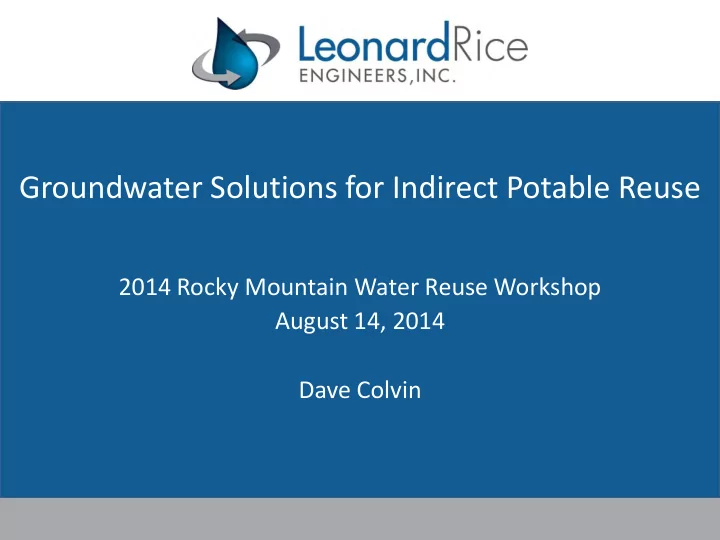

Groundwater Solutions for Indirect Potable Reuse 2014 Rocky Mountain Water Reuse Workshop August 14, 2014 Dave Colvin
Agenda • Types of water reuse groundwater solutions • Benefits • Feasibility project design • Limitations • Conclusions
Types of Groundwater Solutions for IPR • Riverbank Filtration Source: Kelly, B.P., and Rydlund, P.H., Jr., 2006, Water-Quality Changes Caused by Riverbank Filtration Between the Missouri River and Three Pumping Wells of the Independence, Missouri, Well Field 2003–05: U.S. Geological Survey Scientific Investigations Report 2006–5174, 48 p.; http://pubs.usgs.gov/sir/2006/5174/pdf/sir2006-5174.pdf
Types of Groundwater Solutions for IPR • Riverbank Filtration • Soil aquifer treatment Source: http://www.westcas.org/PDF/Fall_2012_presentations/October_2012-SNYDER.pdf
Types of Groundwater Solutions for IPR • Riverbank Filtration Infiltration basins Floodplain • Soil aquifer treatment • Managed Aquifer Recharge Bedrock Alluvial Aquifer
Types of Groundwater Solutions for IPR • Riverbank Filtration • Soil aquifer treatment • Managed Aquifer Recharge • ASR?
Is ASR IPR? Usually treated water is injected and then chlorinated when it is recovered Source: http://www.dep.state.fl.us/geology/geologictopics/asr4/presentations/thursday_15/foreman_agwt4_15_04.pdf
Benefits Reduced treatment costs Attenuates contaminant spikes Bank Storage Easier to permit (some aspects) Source: Barlow, P.M., and Leake, S.A., 2012, Streamflow depletion by wells—Understanding and managing the effects of groundwater pumping on streamflow: U.S. Geological Survey Circular 1376, 84 p. (Also available at http://pubs.usgs.gov/circ/1376/)
Benefits Reduced treatment costs Attenuates contaminant spikes Bank Storage Easier to permit (some aspects) Source: http://www.savingwater.co.za/wp-content/uploads/2012/04/Toilet-tap.jpg Public perception
Aquifer Treatment Contaminant Removal Source: K.M. Hiscock, T. Grischek, 2002. Attenuation of groundwater pollution by bank filtration. Journal of Hydrology, Volume 266, Issues 3–4, 15 September 2002, Pages 139–144 http://dx.doi.org/10.1016/S0022-1694(02)00158-0
Aquifer Treatment Contaminant Removal Mechanism for phosphorus removal Source: K.M. Hiscock, T. Grischek, 2002. Attenuation of groundwater pollution by bank filtration. Journal of Hydrology, Volume 266, Issues 3–4, 15 September 2002, Pages 139–144 http://dx.doi.org/10.1016/S0022-1694(02)00158-0
Water Quality Improvements Target Contaminant Removal • Nutrients: – Nitrogen – Phosphorous • Bacteria/Viruses • Emerging contaminants – Pharmaceuticals and other personal care products – Plasticizers – Pesticides • Prevention of invasive species migration • TOC • TSS • Turbidity • Taste and Odor Source: Kelly, B.P., and Rydlund, P.H., Jr., 2006, Water-Quality Changes Caused by Riverbank Filtration Between the Missouri River and Three Pumping Wells of the Independence, Missouri, Well Field 2003–05: U.S. Geological Survey Scientific Investigations Report 2006–5174, 48 p. http://pubs.usgs.gov/sir/2006/5174/
Water Quality Improvements Target Contaminant Removal • Nutrients: – Nitrogen – Phosphorous • Bacteria/Viruses • Emerging contaminants – Pharmaceuticals and other personal care products – Plasticizers – Pesticides • Prevention of invasive species migration • TOC • TSS • Turbidity • Taste and Odor 13
Water Quality Improvements Target Contaminant Removal • Nutrients: – Nitrogen – Phosphorous • Bacteria/Viruses • Emerging contaminants – Pharmaceuticals and other personal care products – Plasticizers – Pesticides Source: http://growingblue.com/wp- content/uploads/2012/07/PPCPs-in-Water-300×193.jpg
Water Quality Improvements Target Contaminant Removal • Nutrients: – Nitrogen – Phosphorous • Bacteria/Viruses • Emerging contaminants – Pharmaceuticals and other personal care products – Plasticizers – Pesticides • Prevention of invasive species migration
Water Quality Improvements Target Contaminant Removal • Nutrients: – Nitrogen – Phosphorous • Bacteria/Viruses • Emerging contaminants – Pharmaceuticals and other personal care products – Plasticizers – Pesticides • Prevention of invasive species migration • TOC • TSS • Turbidity • Taste and Odor
Groundwater Feasibility Evaluation Evaluating the feasibility of Groundwater Solutions for IPR Water Quantity: Maximize well production IPR Water Capture: Quantify the amount of IPR water captured by the groundwater system Water Quality: Maximize water quality improvements
Groundwater Feasibility – Iterative Phasing
Groundwater Feasibility – Iterative Phasing
Groundwater for IPR Pilot Testing
Groundwater for IPR Pilot Testing
Groundwater for IPR Pilot Testing
Groundwater – Pertinent Data Types • River Stage/ Aquifer Response
Groundwater – Pertinent Data Types • River Stage/ Aquifer Response • Demonstrate capture of river water – Glover analytical methods – MODFLOW numerical model
Groundwater – Pertinent Data Types • River Stage/ Aquifer Response – Maximize • Demonstrate capture of river water – Glover analytical methods – MODFLOW numerical model • Environmental tracers
River Water Capture – Piper Diagram
River Water Capture – Piper Diagram (RBF Test Well)
River Water Capture – Piper Diagram (RBF Test Well)
River Water Capture – Stiff Diagram
River Water Capture – Fluorescence Fingerprint Analyses • Groundwater with lower • Groundwater with percentage of river higher percentage of water river water
Corroborating Model and Water Quality Results
Groundwater Limitations • Water Rights • Regulatory concerns • Rate of groundwater movement • Amount of control • Uncertainty and lack of Source: http://www.onearth.org/files/onearth/water_rights.jpg understanding
Groundwater Limitations • Water Rights • Regulatory concerns • Rate of groundwater movement • Amount of control • Uncertainty and lack of understanding
Groundwater Limitations • Water Rights • Regulatory concerns • Rate of groundwater movement • Amount of control • Uncertainty and lack of understanding
Groundwater Limitations • Water Rights • Regulatory concerns • Rate of groundwater movement • Amount of control • Uncertainty and lack of understanding
Groundwater Limitations • Water Rights • Regulatory concerns • Rate of groundwater movement • Amount of control • Uncertainty and lack of understanding
Groundwater Solutions for IPR Conclusions • Benefits include: – Water quality benefits (nutrients, bacteria, viruses, emerging contaminants, and more) – Public perception improvements – Reduced overall system costs • Feasibility project design can increase likelyhood of success and be the start of permanent infrastructure • Early awareness of limitations can also help with project success
Questions?
Thank You!
Recommend
More recommend